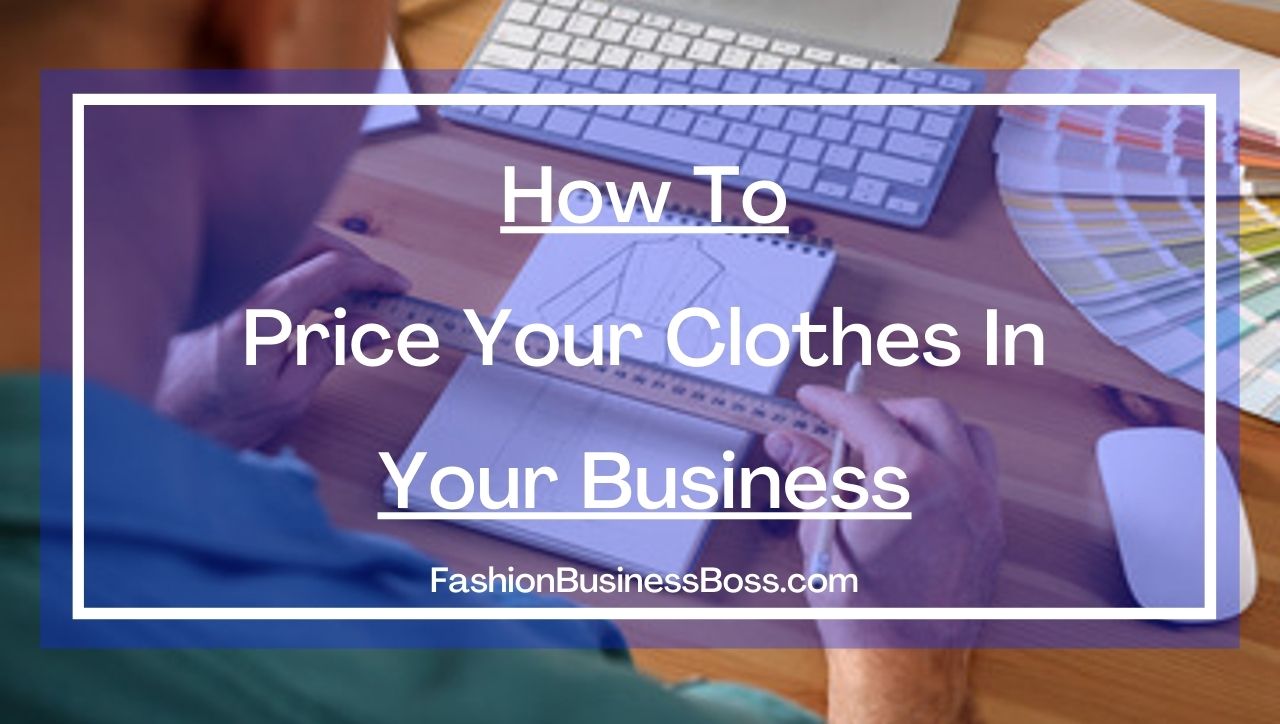Pricing the clothing that you are selling requires a delicate balance. Often consumers hear about the markup in the pricing charged to them to purchase apparel. Mistakenly, this leads customers to believe that they are not being treated well. However, there are many costs to running a business that needs to be included in your pricing.
Pricing your clothes in your own business requires understanding the components of cost, where your brand stands in the pricing hierarchy, and reviewing and selecting an approach to your pricing.
To price your clothes in your business:
- Calculate your cost of goods sold
- Price your brand
- Use the Keystone Markup Method: Cost to manufacture the garment X 2 = Cost item is sold to wholesaler. Wholesaler’s cost X 2 = Retail cost
- Use the Cost Plus Pricing Method. Example: Total cost of item $xx X Markup 1.40 (40%) = Selling price $xx.xx
The numbers and math need to ensure your costs are covered and that you earn an income. However, the perception of the consumer needs to be a component of your pricing strategy. Continue reading for different methodologies to consider in your pricing.
Components of Cost
Before you determine the selling price for your clothing, you need to know all your costs of doing business. Getting your product to your customers involves you spending money. You need to make sure, before you price your clothes, that the price you charge will pay all your bills, your salary, and profits.
Calculating your cost of goods sold, COGS, necessitates listing all your costs. Items to add to your list include –

- Your Products
- The products that you sell. If you sew your own clothing line, you need to include the material, finishing items, and your labor. If someone else sews your clothing, you still need the material, finishing items, their production costs, and shipping. If you purchase items to resell, your costs are what you purchase the items for, make sure that shipping costs are included.
- Marketing Costs
- In this category, you need to include your website, anyone you pay to help with your website including photographs and content writers.
- Your Store
- Here you need to include rent, utilities, and taxes. Also, list office supplies and packaging materials.
- Other
- This might include loan repayments, salaries for you and any staff, licenses, and taxes.
Make Your Clothing Brand Go Viral Using These Tricks!
Pricing your Brand
Before you complete any more calculations, it is important for you to visualize how you want customers to think about your clothing. While you need to cover your costs, your business model can impact how you position your brand. This will influence the percentage profit you are seeking and how you distinguish your brand from competitors.
Before exploring the pricing categories, make sure that you have clearly captured your target customer. Depending on who your clients are or will be, your pricing should consider their approach to shopping.
- Are they bargain hunters?
- Do they want luxury and convenience?
- Can they pay extra for certain types of clothing?
- Are they frequent shoppers?
- Does your clothing line include items that are purchased frequently?
- Or are the items you sell purchased infrequently?
Answering these questions, which will prompt others, will help you determine where your brand should be positioned in pricing.

There are three main categories of pricing to think about. Products perceived as prestigious or luxurious typically have higher prices. Customers expect quality items for this pricing. Items in this group might be specialty clothing for special events, such as weddings. Or a customer may be purchasing a quality coat that is expected to last many seasons.
In the next group, value-pricing, customers look for a blend of quality and pricing. In this pricing sector, customers are expecting clothing that will last a few seasons. The material of the garments should be durable. Last is budget pricing. Affordability is the key focus in these items. Customers are not expecting these garments to last more than a season or two.
Having all three groupings in your store is doable. However, it needs to be apparent to your clients why some goods are so costly. But it can be a benefit to have budget priced items as part of your business. These items, such as basic t-shirts, can continually bring traffic to your store.
Approaches to Pricing
- Keystone Markup Method
There are a multitude of methods to calculate your prices. The first one has been part of the retail world for a while, keystone pricing. It is a very straightforward calculation that relies on marking up your clothing by certain percentages. Traditionally, the mark ups that have been applied in keystoning are one hundred percent or doubling the price. Wholesalers and retailers historically both successfully used this method.
The steps to this calculation are as follows.
Cost to manufacture the garment X 2 = Cost item is sold to wholesaler
Wholesaler’s cost X 2 = Retail cost
To ensure that all taxes were covered, some retailers, in this model, multiplied the wholesaler’s cost by 2.5 to attain their retail cost.
For example, a manufacturer is sewing pants for your store.
$20 to manufacture the pants X 2 = $40 – the cost the wholesaler will be charged
$40 the wholesaler’s cost X 2 = $80 – the price you, as the retailer, affixes to the pants.
Keystone pricing works well for many stores and brands. However, it is not always the best option for all of your goods. Sometimes you will have priced an item too high, which could adversely affect your ability to sell your inventory. Clothing that is readily available in many stores and online might be overpriced in your store using this calculation. Conversely, you might price an item too low and negatively impact your profit. Items that are difficult to find or have import and extra taxes on them might be selling too low.
How To Get Your Clothing Brand Noticed In Four Easy Steps!
- Cost Plus Pricing Method

Also referred to as markup pricing, cost plus pricing requires fairly uncomplicated calculations. If you produce your own clothing, that will be your product cost. If you purchase from a wholesaler, that will equate to your product cost. Then you will add a percentage to cover your other costs and profit.
Details you will need for your calculations are –
- Cost of the product
- Shipping and Handling costs per unit
- Marketing – This needs to be divided by the number of items in your store.
- Overhead costs – rent, insurances, salaries – This needs to be divided by the number of items in your store.
Adding these steps together will provide your cost for the item. For example, if you are selling a sweater, your costs would look like this.
Wholesale cost for sweater = $30
Shipping and handling costs = $ 3
Marketing = $ 1
Overhead costs = $ 8
Total Cost = $42
To add your markup, use this formula.
Cost of sweater $42 X Markup 1.40 (40%) = Selling price $58.80
You can round up or round down your prices. Cost plus pricing ensures that you know your cost per unit. You can adjust the markup on some items. This can help make some items more appealing to your customers, which can increase the sales of the unit. By increasing the number of units sold, you can offset the ‘reduction’ in total sales dollars. This method does not cause you to consider what your competitors are selling comparable items for.
- Absorption Pricing Method

Also referred to as full costing, absorption pricing is another method to consider when pricing your clothes. The price you will end up calculating will include all your fixed and variable costs to run your business. The goal in this strategy is to ensure a solid profit margin for your business. All costs, including setting a profit, are woven into, or absorbed into the prices you set in your store.
You will use the same formula as in cost plus pricing. Now the markup needs to include the amount of profit you need to earn. The intent of including profit in your calculation is looking at the long term of your business. Profits can be reinvested in your business. This is money you would use to expand the size of your store or to purchase your own building for example.
How Much Can A Clothing Store Make Anually?
Related Questions
What is MSRP?
MSRP is an acronym for manufacturer suggested retail price. Manufacturers who are seeking to standardize the dollar amount that their product is sold to consumers will provide an MSRP. This is most often seen on products that are mass produced in large quantities.
What is dynamic pricing?
Dynamic pricing are prices that are constantly being adjusted. Many factors are considered in the calculations for products and services that are priced in this manner. Some of the elements of pricing include – current supply of the goods or services along with the current demand from customers.
What is charm or psychological pricing?
Psychological or charm pricing means that items are priced ending in an odd number, which most frequently is nine. Retailers use this method because shoppers feel that the merchant is trying to provide the best pricing possible. Other customers will see it as a ploy.
What is AOV?
AOV is an abbreviation for average order value. To calculate an AOV, a retailer will add the total sales for the time period, usually a day, and divide that sum by the number of orders during the same time. Increasing AOV is an excellent method to improve sales and profits.
To learn more about how to start your own fashion clothing line check out my startup documents here
Please note: This blog post is for educational purposes only and does not constitute legal advice. Please consult a legal expert to address your specific needs.

Meet Shawn Chun: Entrepreneur and Fashion Business Fan.
I’m a happy individual who happens to be an entrepreneur. I have owned several types of businesses in my life from a coffee shop to an import and export business to an online review business plus a few more and now I create online resources for those interested in starting new ventures. It’s demanding work but I love it. I do it for those passionate about their business and their goals. That’s why when I meet a designer or boutique owner at a craft fair, farmers market, retail location or anywhere else I see myself. I know how hard the struggle is to retain clients, find good employees and keep the business growing all while trying to stay competitive.
That’s why I created Fashion Business Boss: I want to help fashion business owners like you build a thriving business that brings you endless joy and supports your ideal lifestyle.

